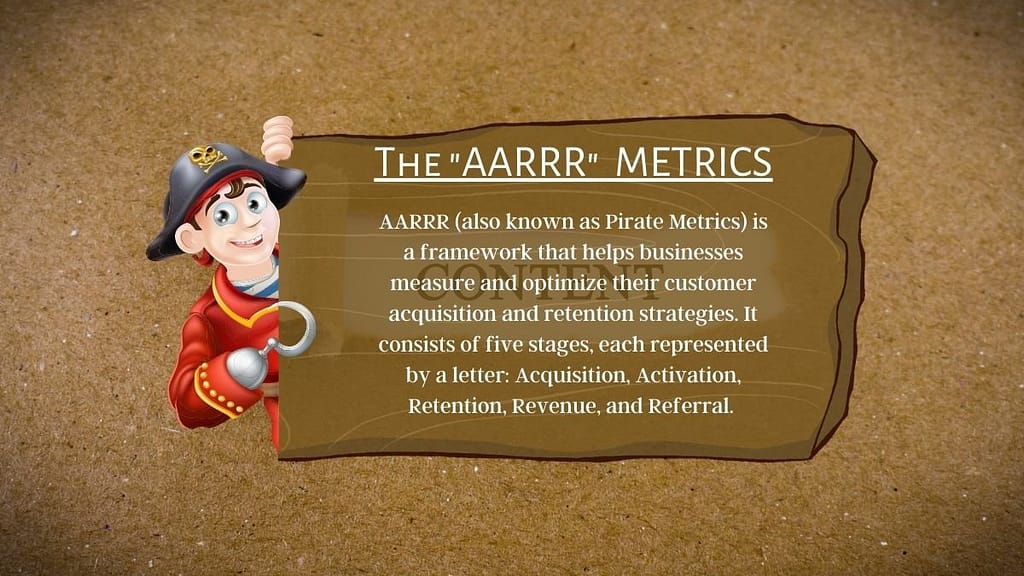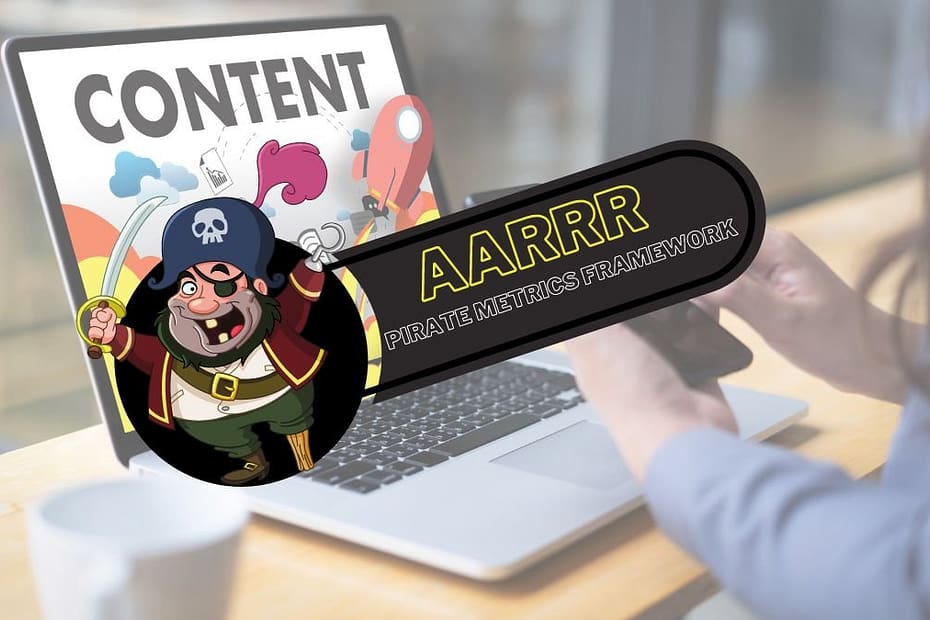When it comes to content marketing, creating effective and successful campaigns is no easy feat. With so many different metrics and factors to consider, it can be difficult to know where to begin.
This is where the AARRR (Pirate Metrics) Framework comes in!
By following this framework, brands can create content that not only engages and educates their target audience, but also leads them down the customer lifecycle and marketing funnel.
But what exactly is the AARRR framework, and how does it relate to content marketing?
In this article, we’ll be exploring the five key components of the framework – Acquisition, Activation, Retention, Revenue, and Referral – and how they align with the different stages of the marketing funnel (TOFU, MOFU, BOFU).
Now, let’s dive in and discover how the AARRR “Pirate Metrics” framework can take your content marketing to the next level!
Table of Contents
AARRR “Pirate Metrics” Framework and Its Significance in Content Marketing
AARRR (also known as Pirate Metrics) is a framework that helps businesses measure and optimize their customer acquisition and retention strategies. It consists of five stages, each represented by a letter: Acquisition, Activation, Retention, Revenue, and Referral.
- Acquistion: Acquisition refers to the process of attracting new customers to your business. This metric helps you understand which channels and strategies are bringing in the most traffic and leads. By tracking acquisition metrics, marketers can understand the effectiveness of their campaigns and optimize them for better results.
- Activation: Activation refers to the process of converting those leads into active users or customers. This metric helps you understand how well your onboarding process is working and whether users are finding value in your product or service. A good activation rate means that new users are easily able to understand and use the product or service, increasing the likelihood of retention and future revenue.
- Retention: Retention refers to the process of keeping those customers engaged and coming back for more. This metric helps you understand how loyal your customers are and whether you are providing enough value to keep them coming back. Tracking retention metrics allows brands to identify and address any issues that may be causing customers to leave.
- Revenue: Revenue refers to the amount of money generated by those customers. This metric helps you understand how much each customer is worth to your business and how you can increase that value over time. By tracking revenue metrics, marketers can understand the financial impact of their content marketing efforts and make data-driven decisions to improve ROI.
- Referral: Referral refers to the process of encouraging your customers to refer others to your business. This metric helps you understand how well you are leveraging your existing customers to bring in new leads and customers. High referral rates indicate that customers are satisfied with the product or service and are willing to recommend it to others.

Essentially, the AARRR “Pirate Metrics” framework can be used in content marketing to measure the effectiveness of different types of content at various stages of the marketing funnel (TOFU, MOFU, BOFU). By understanding how customers engage with content at each stage, businesses can optimize their content marketing efforts to attract and retain customers more effectively.
For example, at the Acquisition stage, businesses can measure the number of visitors to their website and the sources of those visits. At the Activation stage, they can measure the number of sign-ups or downloads. At the Retention stage, they can measure customer engagement and satisfaction. At the Revenue stage, they can measure the conversion rate and revenue generated. Finally, at the Referral stage, they can measure the number of referrals and their impact on customer acquisition.
By using AARRR framework in content marketing, businesses can create a more data-driven approach to their content strategies and make informed decisions to achieve their marketing goals. It can help you to identify areas of your customer journey that need improvement and optimize your marketing and sales strategies accordingly, as well as to create content that aligns with each stage of the customer journey and drives conversions and retention.
Mapping Your Content to the Customer Lifecycle and Marketing Funnel
When it comes to creating effective content marketing campaigns, it’s important to understand the customer lifecycle and marketing funnel. The customer lifecycle refers to the stages a customer goes through from the initial contact with your brand to becoming a loyal customer.
The marketing funnel, on the other hand, refers to the process of turning leads into customers through a series of three stages. This include:
- Top of the Funnel (TOFU): At the top of the funnel, customers become aware of a brand’s products or services. This stage is all about creating awareness and generating interest. Content marketing tactics such as blog posts, social media content, and video marketing are commonly used at this stage.
- Middle of the Funnel (MOFU): At the middle of the funnel, customers have shown some interest in the brand and are considering making a purchase. This stage is about building a relationship with customers and educating them about the brand and its products. Tactics such as case studies, webinars, and email marketing are commonly used at this stage.
- Bottom of the Funnel (BOFU): At the bottom of the funnel, customers are ready to make a purchase. This stage is about converting prospects into customers and retaining them. Tactics such as product demos, free trials, and customer testimonials are commonly used at this stage.

Now let’s see how AAARR “Pirate Metrics” framework correspond to the stages of the marketing funnel:
- Acquisition: Acquisition corresponds to the top of the funnel stage. This metric measures how many new visitors are coming to the website or engaging with the brand’s content. At this stage, the goal is to attract as many relevant visitors as possible to create awareness and generate interest.
- Activation: Activation corresponds to the middle of the funnel stage. This metric measures how many visitors have taken a specific action, such as signing up for a newsletter or downloading a whitepaper. At this stage, the goal is to build a relationship with prospects and educate them about the brand.
- Retention: Retention corresponds to the bottom of the funnel stage. This metric measures how many customers are returning and continuing to engage with the brand. At this stage, the goal is to retain customers and keep them engaged with the brand’s products or services.
- Revenue: Revenue corresponds to the bottom of the funnel stage. This metric measures how much revenue the brand is generating from its customers. At this stage, the goal is to convert prospects into paying customers and maximize their lifetime value.
- Referral: Referral corresponds to all stages of the marketing funnel. This metric measures how many customers are referring new customers to the brand. At every stage, the goal is to create a positive customer experience that encourages customers to refer others to the brand.
Tracking AARRR metrics at each stage of the funnel is essential to optimizing content marketing campaigns. For example, if a brand is struggling to attract new visitors (Acquisition), they may need to focus on improving their SEO or social media strategy. Or if a brand is struggling to retain customers (Retention), they may need to improve their customer support or loyalty program.
When mapping your content to the customer lifecycle and marketing funnel, it’s important to consider the different formats and channels that are most effective at each stage. At the top of the funnel, visual content like infographics and videos can be highly effective at grabbing attention and driving awareness.
In the middle of the funnel, longer-form content like blog posts and webinars can be effective at providing valuable information and building trust. Finally, at the bottom of the funnel, product demos and case studies can be highly effective at demonstrating the value of your products or services.
In terms of channels, social media can be highly effective at driving awareness and engagement at the top of the funnel, while email marketing can be effective at nurturing leads through the middle of the funnel. Finally, paid advertising and retargeting can be highly effective at converting leads into customers at the bottom of the funnel.
Applying AARRR “Pirate Metrics” Framework in Content Marketing
Now that we understand the importance of AARRR “Pirate Metrics” framework in content marketing and how they correspond to the marketing funnel’s stages, let’s explore how to apply these metrics to create effective content marketing campaigns at each stage of the funnel.
The AARRR Pirate Metrics framework can be used to track customer behavior at each stage of the funnel. For example, in the acquisition stage (top of the funnel), you can track website traffic and social media engagement to see how effective your content is at driving awareness.
In the activation stage (early middle of the funnel), you can track email signups and other forms of lead capture to see how effective your content is at engaging potential customers.
Similarly, in the retention stage (late middle of the funnel), you can track customer engagement and repeat purchases to see how effective your content is at keeping customers engaged. And in the revenue stage (bottom of the funnel), you can track sales and revenue to see how effective your content is at driving conversions.
Finally, in the referral stage, you can track social shares and word-of-mouth referrals to see how effective your content is at encouraging customers to refer your brand to others.
Here’s how you can track your content marketing efforts’ performance per stage:
- Acquisition: In this stage, you want to attract potential customers to your website or social media pages. You can track your Acquisition metrics by monitoring website traffic, social media engagement, and email sign-ups. To optimize your content for this stage, focus on creating engaging and shareable content that appeals to your target audience.
- Activation: Once you have attracted potential customers to your website or social media pages, you want to encourage them to take a specific action, such as downloading an eBook or subscribing to a newsletter. You can track your Activation metrics by monitoring conversion rates, such as the percentage of website visitors who sign up for your email list. To optimize your content for this stage, make sure your calls-to-action are clear and compelling, and that your landing pages are optimized for conversion.
- Retention: After you have converted potential customers into actual customers, you want to keep them engaged and coming back for more. You can track your Retention metrics by monitoring customer retention rates, repeat purchases, and customer feedback. To optimize your content for this stage, focus on creating high-quality, valuable content that keeps your customers engaged and informed. Use email marketing and social media to stay in touch with your customers and provide them with personalized content.
- Revenue: At this stage, you want to focus on generating revenue from your existing customer base. You can track your Revenue metrics by monitoring sales revenue, average order value, and customer lifetime value. To optimize your content for this stage, focus on creating content that promotes your products or services in a way that resonates with your customers. Use email marketing and social media to promote special offers and promotions.
- Referral: Finally, you want to encourage your customers to refer their friends and colleagues to your business. You can track your Referral metrics by monitoring referral rates, social media shares, and customer reviews. To optimize your content for this stage, focus on creating content that is shareable and encourages your customers to refer their friends and colleagues. Use social media and email marketing to encourage referrals and provide incentives for referrals.
Conclusion
In conclusion, the AARRR Pirate Metrics framework is a powerful tool that can help businesses optimize their content marketing strategies. By tracking the five metrics – Acquisition, Activation, Retention, Revenue, and Referral – businesses can better understand their customers’ journeys and tailor their content to meet their needs at each stage of the funnel.
The marketing funnel, combined with the customer lifecycle, provides a helpful structure for mapping content to each stage and addressing the needs and pain points of customers throughout their journey.
To create an effective content marketing strategy, it’s crucial to use the AARRR Pirate Framework to measure and optimize campaigns at each stage of the funnel. This means creating content that speaks to the specific needs and interests of customers at each stage, using the most effective channels and formats to reach them, and constantly tracking and analyzing results to make data-driven decisions.
Overall, the AARRR framework offers a valuable tool for businesses looking to improve their content marketing efforts and achieve long-term success in the ever-changing digital landscape.
FAQs
1. What are AARRR Pirate Metrics?
AAARR Pirate Metrics are a set of five key performance indicators (KPIs) used to measure the effectiveness of a business’s marketing efforts at different stages of the customer journey.
2. How are AARRR Pirate Metrics different from traditional marketing metrics?
AARRR Pirate Metrics are different from traditional marketing metrics as they focus on the entire customer journey rather than just the initial stages of customer acquisition.
3. How can AARRR Pirate framework help improve content marketing campaigns?
The AARRR Pirate framework can help improve content marketing campaigns by providing insights into areas of strength and weakness, identifying opportunities for improvement, and helping to measure the ROI of marketing efforts.
4. What are the benefits of using the AARRR Pirate framework in content marketing?
The benefits of using the AARRR Pirate framework in content marketing include improved understanding of customer behavior, better targeting and personalization, increased ROI, and more effective resource allocation.
5. How do I track the AARRR Pirate Metrics?
The AARRR Pirate Metrics can be tracked using various tools and platforms, including Google Analytics, Mixpanel, and KISSmetrics.
6. How can I use AARRR Pirate Metrics to identify areas of improvement in my content marketing strategy?
AARRR Pirate Metrics can be used to identify areas of improvement in a content marketing strategy by analyzing data to identify patterns, trends, and customer preferences.
7. How do AARRR Pirate Metrics relate to the customer lifecycle and the marketing funnel?
AARRR Pirate Metrics relate to the customer lifecycle and marketing funnel by providing a framework for measuring marketing success at each stage of the customer journey.
8. What are some effective strategies for optimizing content for each stage of the marketing funnel using AARRR Pirate Metrics?
Effective strategies for optimizing content for each stage of the marketing funnel using AARRR Pirate Metrics include creating targeted content, personalizing messaging, and using retargeting campaigns.
9. What are some best practices for using AARRR Pirate Metrics in content marketing?
Best practices for using AARRR Pirate Metrics in content marketing include setting specific goals, using a variety of metrics, and regularly reviewing and adjusting strategies based on data.
10. How can I use AARRR Pirate Metrics to identify opportunities for growth and expansion in my business?
AARRR Pirate Metrics can be used to identify opportunities for growth and expansion in a business by analyzing customer behavior and preferences, and identifying areas for improvement in the customer journey.
11. What are some common mistakes to avoid when using AARRR Pirate Metrics in content marketing?
Common mistakes to avoid when using AARRR Pirate Metrics in content marketing include focusing too much on vanity metrics (such as pageviews or social media followers) rather than metrics that directly impact business outcomes, failing to measure or optimize for each stage of the customer lifecycle, and neglecting to analyze and act on the data.
12. How can I use AARRR Pirate Metrics to improve customer retention and increase lifetime value?
By tracking metrics such as retention rate and customer lifetime value, you can identify areas where you can improve the customer experience and build stronger relationships with your audience. For example, you might use personalized email campaigns or loyalty programs to encourage repeat purchases and build brand loyalty.







